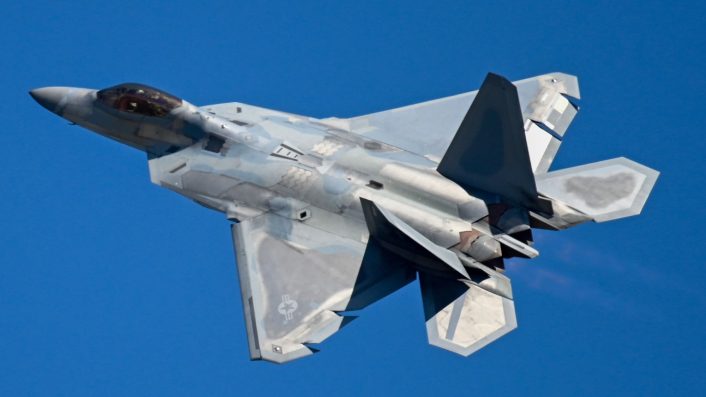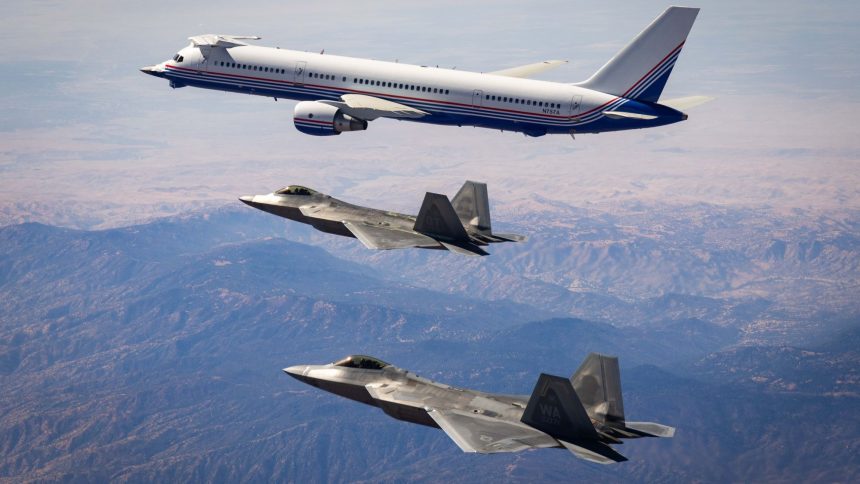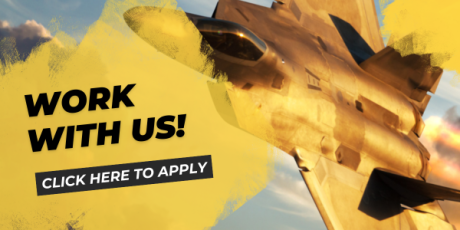The Boeing 757 FTB is the F-22’s highly modified and instrumented aircraft that tests avionics and systems, saving costs and development timelines.
Amid reports of the F-22 Raptor being slated to receive a series of software and hardware upgrades, Edwards AFB, California, released on the DVIDS network an image on Apr. 25, 2025, showing two F-22 Raptors flying with their associated Boeing 757 Flying Test Bed (FTB ) N757A. The photo is not recent, as it was captureds on Oct. 23, 2024, but its publication comes a few months after U.S. Air Force officials revealed that the Raptor underwent six developmental flight tests to rapidly prototype new sensors and hardware to enhance its survivability.
The Raptors, assigned to the 411th Flight Test Squadron at Edwards, were flying with N757A (also known my many as “Catfish” due to its unique appearance) in a collaborative effort between the Air Force Operational Test and Evaluation Center, Lockheed Martin and Boeing, within the Air Dominance Combined Test Force. The 411th FTS, AFOTEC, Lockheed, Boeing are working “together within the Air Dominance CTF at Edwards AFB to test capability enhancements for the F-22 Raptor,” the caption said.
“This includes early integration with warfighters through combined developmental and operational testing efforts,” further added the caption. Edwards AFB said: “Our Air Dominance Combined Test Force is increasing F-22 Raptor lethality through early integration with developmental test, operational test, and private industry.”
What the image suggests
The Air Dominance CTF evolved from the F-22 Raptor CTF in Jun. 2023, to “be tasked with flight testing the Next Generation Air Dominance (NGAD) Family of Systems.” This appears to suggest that previous reports about an undisclosed relationship between the F-22 Raptor and the NGAD – now designated as the F-47 – have some credence.
This is especially after Boeing was chosen as the F-47’s primary contractor and is now being mentioned as being part of the Air Dominance CTF. However, the mention of Boeing in the latest images could simply be regarding the FTB being manufactured and modified by the company and, at least as of now, have nothing to do with the F-47 NGAD.
Nevertheless, it does show that the Air Force is rapidly moving towards integrating new advanced hardware and technology on the F-22, with the help of the Boeing 757 FTB, and we might see the Raptor with some new, possibly external, features soon. Over the last year, Lockheed Martin and Raytheon were awarded contracts to upgrade the F-22 Raptors.
The Air Force presently has 180 Raptors, with 32 in an older configuration and largely used for flight testing and training. Initial plans to retire these older Raptors were also reconsidered.

F-22 upgrades – pods and tanks
The F-22 is slated for a series of hardware and software upgrades worth $7.8 billion before 2030, which includes $3.1 billion for research and development and $4.7 billion in procurement. The latest were announced by Lockheed Martin on Jan. 22, 2025, revealing a $270 million contract to integrate an IRDS (Infrared Defensive System), which adds a set of TacIRST (Tactical Infrared Search and Track) sensors around the aircraft.
The small, compact, open architecture-based sensor offers reconnaissance, threat warning and, unlike traditional IRST with round windows, is based on a smaller staring sensor, similar the F-35’s Distributed Aperture System, and will be flush with the F-22’s surfaces. Lockheed Martin had said that the TacIRST will be embedded in the F-22 instead of pods, implying some external paneling and possibly minor airframe work.
Other upgrades figured in the Fiscal Year 23 budget requests and in an official artwork shared by Gen. Mark Kelly, then Commander of Air Combat Command. That artwork showed three Raptors carrying new stealthy external fuel tanks, two underwing faceted pods and a new unknown air-to-air missile.
As mentioned earlier, the documents also revealed a previously undisclosed relationship between the F-22 and the NGAD. The pods were reminiscent of the one seen in Feb. 2022 during flight testing of an F-22 at the Air Force’s Plant 42 in Palmdale, California, and in Jul. 2024 were seen installed under a Rockwell Sabreliner 65 testbed jet at Nellis AFB. We concluded that these pods could may have different variants, housing IRST and other sensors.
N33TR, a Rockwell Sabreliner 65 for Airborne Imaging returns to KJWY/Mid-Way regional Airport as ” AIRBORNE33 ” carrying one of the future F-22 pods.
It was at Nellis AFB testing the pod alongside RATT55/NT-43A, a radar test bed that regularly flies alongside B-2s. pic.twitter.com/kNADnga7H0
— 𝙎𝙍_𝙋𝙡𝙖𝙣𝙚𝙨𝙥𝙤𝙩𝙩𝙚𝙧 (@SR_Planespotter) July 1, 2024
Four months prior, in Mar. 2024, the stealthy fuel tanks, identified as LDTP (Low Drag and Pylons), were captured for the first time in an unofficial photograph of an F-22 Raptor near the Mojave Air and Space Port. The tanks are stealthier and more aerodynamically efficient than the current 600-gallon fuel tanks and, according to the FY2023 budget papers, retain supersonic flight with a smooth wind swept surface with minimum drag.
The document also mentioned the introduction of a Mode 5 Identification Friend or Foe (IFF); Link 16; Multifunction Information Distribution System Joint Tactical Radio System (MIDS JTRS); a new Operational Flight Program; advanced radar Electronic Protection, Embedded GPS/Inertial Navigation System (INS) Modernization (EGI-M), Open System Architecture (OSA), new encrypted radios.
Cropped into oblivion but this is the first time I’ve seen the LO fuel tanks and pods on the F-22 https://t.co/CpqnouNYO8 pic.twitter.com/srOgbeht1e
— TaskForce23 (@Task_Force23) March 22, 2024
Other sensors for rapid prototyping
In Aug. 2024, Program Executive Officer for Fighters and Advanced Aircraft Brig. Gen. Jason D. Voorheis revealed during the Life Cycle Industry Days conference that the F-22 conducted six test flights to demonstrate advanced sensors and rapidly prototype them to be fielded quickly. This sheds some light on the latest image of the two Raptors with the Catfish and the work being done at the time.
That report was followed by the U.S. Air Force announcing on Aug. 29, 2024 a $1 billion contract to RTX’s Raytheon to upgrade the Raptor with a series of new “Group B hardware” sensors to enhance its survivability. It was possible that some of these sensors could be the stealthy pods seen on the F-22 mentioned above, which, as Air and Space Forces later confirmed through officials, host an IRST.
The Air Force also aims to upgrade the remaining 154 F-22s with new cryptography, an expanded open architecture, new weapons and an advanced threat warning receiver, beside the IRST. Voorheis also mentioned the GRACE (Government Reference Architecture Compute Environment) software that would allow “non-traditional F-22 software” to provide “additional processing and pilot interfaces.”

Test flights with the ‘Catfish’
These flights may have happened between the beginning of 2024 to around the time Voorheis spoke at the Aug. 2024 event. The latest photo on DVIDS, which as we mentioned was taken on Oct. 23, 2024 and posted only on Apr. 25, 2025, suggests these test flights continued well towards the end of 2024.
As The Aviationist detailed in its feature about the Boeing 757 FTB (N757A), the highly modified and instrumented aircraft tests avionics, sensors and systems meant for the F-22 in an open-air, operationally representative environment. It carried out in-flight tests of the systems even before the first Raptor flew, in order to speed up its development. The aircraft employs a simulated F-22 cockpit in the cabin that embeds primary and secondary F-22 displays, as well as a throttle and stick, with engineers and technicians validating their performance.
Catfish
The infamous N757A “#Catfish“, the first #Boeing 757-200 ever built was later extensively modified for use by #Lockheed Martin as a testbed for F-22 and F-35 sensor and avionics integration. 1/n#IADN #IADN_infobites pic.twitter.com/T36mfyO2g8
— News IADN (@NewsIADN) November 17, 2022
The 757 additionally carries an F-22 radar housed in the forward fuselage section in a distinctive nose and a sensor wing on its crown immediately behind the flight deck. The FTB has routinely flown with F-22s at Nellis and Edwards AFBs in Nevada and California for rapid trialing of software before its release to developmental flight testers, mainly at Edwards.









